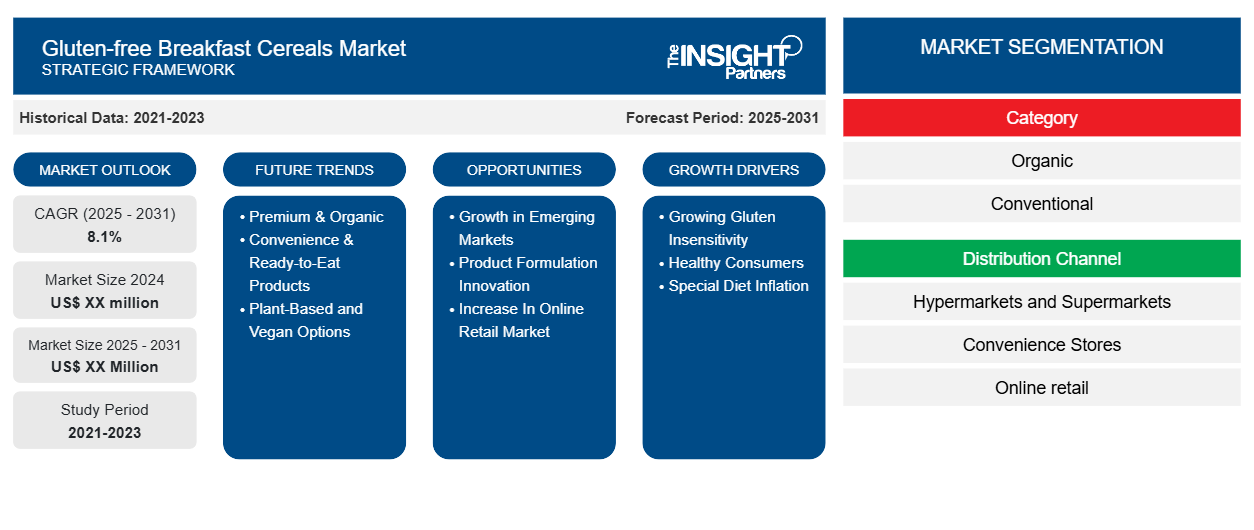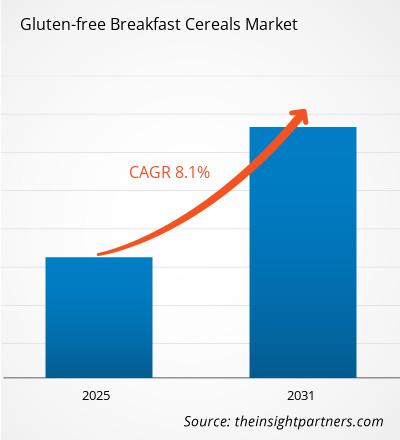Le marché des céréales de petit-déjeuner sans gluten devrait enregistrer un TCAC de 8,1 % de 2025 à 2031, avec une taille de marché passant de XX millions de dollars américains en 2024 à XX millions de dollars américains d'ici 2031.
Le marché des céréales sans gluten pour petit-déjeuner est segmenté par catégorie : bio et conventionnel, et par canal de distribution : hypermarchés et supermarchés, commerces de proximité, vente en ligne, etc. Les projections jusqu'en 2031 examinent la croissance des céréales sans gluten fonctionnelles et enrichies, ainsi que la demande des consommateurs pour des produits à faible teneur en sucre et à haute teneur en protéines. Des analyses régionales et des informations clés par pays sont incluses, le marché étant évalué en dollars américains.
Objet du rapport
Le rapport sur le marché des céréales de petit-déjeuner sans gluten, publié par The Insight Partners, vise à décrire le paysage actuel et la croissance future, ainsi que les principaux moteurs, défis et opportunités. Il fournira des informations aux différents acteurs du secteur, notamment :
- Fournisseurs/fabricants de technologies : pour comprendre l’évolution de la dynamique du marché et connaître les opportunités de croissance potentielles, leur permettant de prendre des décisions stratégiques éclairées.
- Investisseurs : réaliser une analyse complète des tendances concernant le taux de croissance du marché, les projections financières du marché et les opportunités qui existent tout au long de la chaîne de valeur.
- Organismes de réglementation : Réglementer les politiques et les activités de police sur le marché dans le but de minimiser les abus, de préserver la confiance des investisseurs et de maintenir l’intégrité et la stabilité du marché.
Segmentation du marché des céréales de petit-déjeuner sans gluten
Catégorie
- Organique
- Conventionnel
Canal de distribution
- Hypermarchés et supermarchés
- Dépanneurs
- Vente au détail en ligne
- Autres
Vous bénéficierez d'une personnalisation gratuite de n'importe quel rapport, y compris des parties de ce rapport, ou d'une analyse au niveau des pays, d'un pack de données Excel, ainsi que de superbes offres et réductions pour les start-ups et les universités.
Marché des céréales de petit-déjeuner sans gluten : perspectives stratégiques

-
Obtenez les principales tendances clés du marché de ce rapport.Cet échantillon GRATUIT comprendra une analyse de données, allant des tendances du marché aux estimations et prévisions.
Moteurs de croissance du marché des céréales de petit-déjeuner sans gluten
- Insensibilité croissante au gluten : Alors que de plus en plus de personnes sont diagnostiquées avec la maladie cœliaque ou tentent de manger sans gluten pour des raisons de santé, la demande de céréales de petit-déjeuner sans gluten augmente. Cette attitude est particulièrement évidente dans les supermarchés occidentaux, où les consommateurs sont conscients des dangers du gluten pour la santé.
- Consommateurs soucieux de leur santé : Les consommateurs se soucient de leur santé et achètent des céréales non seulement sans gluten, mais aussi riches en fibres et pauvres en sucres et minéraux. Cela incite les fabricants à innover pour proposer des options sans gluten plus saines.
- Inflation des régimes spéciaux : les régimes comme Paleo, Keto, Whole30 et bien d'autres mettent l'accent sur les aliments sans céréales et sans gluten et les céréales de petit-déjeuner sans gluten ont été développées pour répondre aux demandes des personnes suivant ces régimes.
- Disponibilité d’ingrédients plus sains : L’accès croissant aux céréales sans gluten (quinoa, sarrasin, millet) et aux protéines et fibres végétales permet aux fabricants de fabriquer des céréales sans gluten qui sont nutritives et attrayantes pour le consommateur soucieux de sa santé.
Tendances futures du marché des céréales de petit-déjeuner sans gluten
- Premium et Bio : La demande de céréales sans gluten bio de qualité supérieure (ou, plus fréquemment, avec des céréales bio et des édulcorants naturels) augmente parmi un large groupe de consommateurs à la recherche de produits premium et clean label.
- Produits de commodité et prêts à consommer : La demande de produits de petit-déjeuner rapides et prêts à consommer est en plein essor, sans compromis sur la nutrition. Cela donne naissance à des céréales de petit-déjeuner sans gluten, prêtes à consommer et prêtes à consommer.
- Options végétales et végétaliennes : À mesure que les régimes à base de plantes gagnent en popularité, les céréales sans gluten contenant des protéines végétales et des produits laitiers (lait de noix, etc.) gagnent en popularité. Des céréales végétaliennes sans gluten arrivent sur le marché pour répondre aux besoins de cette population.
- Ajouts de nutriments et de composés fonctionnels : De nombreuses céréales de petit-déjeuner sans gluten ajoutent des fibres, des protéines, des vitamines et des minéraux pour plaire aux consommateurs soucieux de leur santé qui ne veulent pas simplement des céréales.
Opportunités de marché pour les céréales de petit-déjeuner sans gluten
- Croissance dans les marchés émergents : Alors que la tendance sans gluten prévaut en Occident, il existe une opportunité d'expansion dans les marchés émergents tels que l'Asie et l'Amérique latine, car de plus en plus de personnes sur ces marchés prennent conscience de la sensibilité au gluten et des problèmes de santé qui y sont liés lorsqu'elles consomment du gluten.
- Innovation en matière de formulation de produits : Il y a tant à inventer sur le marché des céréales de petit-déjeuner sans gluten, comme le développement de nouvelles saveurs, de variations de céréales et de nouveaux ingrédients fonctionnels qui plaisent aux consommateurs qui ne se contentent pas de céréales simples.
- Augmentation du marché de détail en ligne : les céréales de petit-déjeuner sans gluten, les consommateurs achetant davantage leurs aliments en ligne, sont dans une position privilégiée pour atteindre le marché du commerce électronique en offrant un accès facile et une large gamme de produits aux clients.
- Personnalisation en fonction des besoins de santé : Les besoins de santé étant devenus bien connus, tels que la perte de poids ou le contrôle du diabète, les céréales sans gluten contenant des ingrédients spéciaux pour répondre à ces besoins (par exemple, riches en protéines, faibles en glucides) peuvent cibler un marché spécialisé.
Aperçu régional du marché des céréales de petit-déjeuner sans gluten
Les tendances régionales et les facteurs influençant le marché des céréales sans gluten pour petit-déjeuner tout au long de la période de prévision ont été analysés en détail par les analystes de The Insight Partners. Cette section aborde également les segments et la géographie du marché des céréales sans gluten pour petit-déjeuner en Amérique du Nord, en Europe, en Asie-Pacifique, au Moyen-Orient et en Afrique, ainsi qu'en Amérique du Sud et en Amérique centrale.
Portée du rapport sur le marché des céréales de petit-déjeuner sans gluten
| Attribut de rapport | Détails |
|---|---|
| Taille du marché en 2024 | XX millions de dollars américains |
| Taille du marché d'ici 2031 | XX millions de dollars américains |
| TCAC mondial (2025 - 2031) | 8,1% |
| Données historiques | 2021-2023 |
| Période de prévision | 2025-2031 |
| Segments couverts |
Par catégorie
|
| Régions et pays couverts |
Amérique du Nord
|
| Leaders du marché et profils d'entreprises clés |
|
Densité des acteurs du marché des céréales sans gluten : comprendre son impact sur la dynamique commerciale
Le marché des céréales sans gluten pour petit-déjeuner connaît une croissance rapide, porté par une demande croissante des consommateurs, notamment en raison de l'évolution des préférences des consommateurs, des avancées technologiques et d'une meilleure connaissance des bienfaits du produit. Face à cette demande croissante, les entreprises élargissent leur offre, innovent pour répondre aux besoins des consommateurs et capitalisent sur les nouvelles tendances, ce qui alimente la croissance du marché.

- Obtenez un aperçu des principaux acteurs du marché des céréales de petit-déjeuner sans gluten
Principaux arguments de vente
- Couverture complète : Le rapport couvre de manière exhaustive l'analyse des produits, des services, des types et des utilisateurs finaux du marché des céréales de petit-déjeuner sans gluten, offrant un paysage holistique.
- Analyse d’experts : Le rapport est compilé sur la base d’une compréhension approfondie des experts et analystes du secteur.
- Informations à jour : Le rapport garantit la pertinence commerciale en raison de sa couverture des informations récentes et des tendances des données.
- Options de personnalisation : ce rapport peut être personnalisé pour répondre aux exigences spécifiques des clients et s'adapter de manière appropriée aux stratégies commerciales.
Le rapport de recherche sur le marché des céréales de petit-déjeuner sans gluten peut donc contribuer à décrypter et à comprendre le contexte et les perspectives de croissance du secteur. Malgré quelques inquiétudes légitimes, les avantages globaux de ce rapport l'emportent généralement sur les inconvénients.
- Analyse historique (2 ans), année de base, prévision (7 ans) avec TCAC
- Analyse PEST et SWOT
- Taille du marché Valeur / Volume - Mondial, Régional, Pays
- Industrie et paysage concurrentiel
- Ensemble de données Excel
Rapports récents
Rapports connexes
Témoignages
Raison d'acheter
- Prise de décision éclairée
- Compréhension de la dynamique du marché
- Analyse concurrentielle
- Connaissances clients
- Prévisions de marché
- Atténuation des risques
- Planification stratégique
- Justification des investissements
- Identification des marchés émergents
- Amélioration des stratégies marketing
- Amélioration de l'efficacité opérationnelle
- Alignement sur les tendances réglementaires






















 Obtenez un échantillon gratuit pour - Marché de céréales pour petit-déjeuner sans gluten
Obtenez un échantillon gratuit pour - Marché de céréales pour petit-déjeuner sans gluten